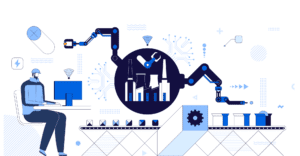Implementing AI machine learning in your team
In this article, we discuss implementing AI and machine learning in your team, covering benefits, challenges, and best practices for effective integration.

According to a recent Deloitte survey, 73% of businesses say artificial intelligence (AI) is critical to their success, yet 41% of technologists are concerned about the ethics of the AI tools their company uses. Additionally, 47% of business leaders have concerns about transparency. While many leaders quickly recognize the contributions AI Integration can make, there is still a lingering distrust in its capability.
Let’s explore why some businesses have difficulty trusting AI and why it’s crucial to integrate it into your team.
Understanding the concerns around AI integrationCopied
When it comes to using AI for mission-critical tasks, there are two main areas of concern for businesses:
The need for transparency
The ability of users to understand the data that goes into a model is critical when building trust in an AI system.
To ensure that algorithms are functioning as expected, companies must be transparent about how they train their AI models and what information they use when making decisions. This helps organizations maintain trust by showing customers exactly how their data is being used. It also allows companies to explain why certain decisions were made and allow customers to provide feedback.
The need for ethical guidelines
AI systems are only as ethical as their users allow them to be. Without clear standards in place, there is no guarantee that an algorithm will act ethically – or make decisions in line with organizational values or customer expectations.
Companies need to put ethical guidelines in place so that they can ensure their algorithms are compliant with any applicable laws or regulations. This helps protect organizations from potential legal repercussions, and allows them to demonstrate their commitment to ethical practices.
Can AI be part of your team?Copied

For organizations to successfully incorporate AI into their teams, they must first build trust in the technology.
Doing this effectively requires:
Integrating human judgment into the process
To overcome concerns about trustworthiness, managers need to understand human judgment’s role in developing AI models.
As opposed to traditional programming (which depends on human input to learn), machine learning algorithms can be trained using datasets derived from real-world examples. Team members must interpret and label this data before feeding it into an algorithm. In other words, human resources have an integral role in creating accurate AI models that businesses can trust.
As such, managers must ensure that their team members have solid ethical foundations and understand AI technology’s capabilities and limitations. It is also essential for them to recognize potential biases in their datasets, so they can adjust accordingly.
By taking these steps, managers can create teams with high levels of trustworthiness when working on sensitive tasks such as customer service or security operations.
The role of explainability in AI-powered team
In this era of AI and machine learning, Explainable Artificial Intelligence (XAI) provides an essential bridge of understanding and trust between man and machine. By utilizing XAI processes and methods, we can better comprehend the actions of our algorithms, and trust that they are reliable in their output without needing a deep understanding of how they work. XAI allows us to build and achieve our goals with more precision and accuracy than ever before, making it possible to create a world in which we can use machines with confidence.
To achieve this, you must be able to thoroughly explain the decision-making process and logic for a particular recommendation. Clearly explain why it is so important for users to understand the data that went into a model, so they can be more confident in its decisions and recommendations.
Explainability also plays a vital role in helping organizations meet regulatory compliance requirements, as it ensures that decisions made by algorithms are transparent and traceable.
Reducing bias within algorithms is another benefit of XAI, as all factors considered when deciding have been vetted and documented.
Finally, explainability can help organizations to build trust with their customer base by clarifying how decisions were made and why specific recommendations were given.
How can organizations achieve explainability?
There are several ways for organizations to ensure that their algorithms are explainable.
These include using data audit logs, which:
- Provide detailed information about how data was used
- Create automated tests that check for bias in models
- Use natural language processing (NLP) techniques such as sentiment analysis
- Implement machine learning interpretability methods such as feature importance analysis or partial dependence plots
Additionally, organizations should consider investing in XAI, which focuses on developing systems that can generate comprehensible explanations for their behavior and decisions.
The benefits of human-AI collaborationCopied

When done correctly, human-AI collaboration can bring tremendous value to any organization.
For example, chatbots powered by NLP allow businesses to interact with customers on multiple real-time channels while reducing manual labor costs.
Another example would be predictive analytics, which leverage machine learning algorithms to forecast customer behavior or detect anomalies – allowing companies to identify trends faster than ever.
Ultimately, combining human judgment with advanced technologies allows teams to maximize efficiency while reducing risk factors associated with decision-making processes.
ConclusionCopied
Successful collaboration between your workforce and AI is essential for any organization to remain competitive. Business leaders must ensure that AI models are trustworthy, accurate, and explainable.
AG5 skills management software helps coordinate and optimize human-AI collaboration. Our software allows users to create profiles that capture each team member’s skills, knowledge, experience, and qualifications. This helps managers assign the right people to projects or tasks based on their skill sets.
By leveraging AG5 skills management software, businesses can ensure that their teams are well-equipped with the necessary skills to make accurate decisions while maintaining trustworthiness and transparency. Schedule a free live demo!

